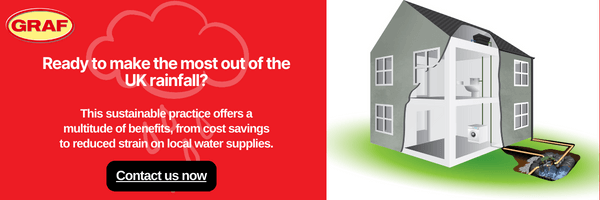What is a Rainwater Harvesting System?
The UK is well known for its rainy weather, even during the summer months we have days when it rains. Did you know in 2020 out of 365 days, over 163 were rainy? That meant for almost half the time in the UK it was raining.
But it’s not all doom and gloom. You can take advantage of the rainfall to use less water from your mains supply. How? By harvesting the rainfall.
What is Rainwater Harvesting
Rainwater harvesting is the process of collecting the rainfall from your roof and storing it to use for other things around the home. You can use harvested rainwater just for the garden and keep a water butt outside, or you can have a tank with a pump and filter system fitted so that you can use rainwater inside too.
Where can you use rainwater in your home?
Rainwater can be used to water your lawn and garden. Inside your home, harvested rainwater can be used to flush toilets, and wash clothes in the washing machine.
What are the advantages of harvesting rainwater?
The biggest advantage is that you will save money on your water bill as mains water usage can reduce by up to 50%. The costs of installation will reduce your water usage from the mains and therefore lower your bills. Once the payment period for the installation has passed your rainwater is free.
The other advantage is that a rainwater harvesting system will reduce the amount of run-off you have from rainwater, so if your property tends to become waterlogged in heavy rain this will be reduced as the rain is directed into the water tank. That means there is a reduced risk of flooding too.
What equipment do I need?
If you only want rainwater for use in the garden all you’ll need is a water butt of your chosen size. But if you want to use rainwater in the home you’ll need:
- A tank that is usually placed underground, but if that’s not possible it can be located above ground
- A tank cover
- A filter package
- A pump package
Are the water tanks big and heavy?
There are water tanks designed to hold from 200 litres up to a commercial capacity of 52,000 litres. They are strong but lightweight and easy to install.
How do you know the size of the tank you need?
Here at Graf, we ask you a few questions online and we then assess the answers and tell you what size tank you’ll need. The questions include letting us know the size of your roof and your postcode to have a look at your average rainfall. We also need to know how many people live in your household and how you want to use the collected rainwater.
How Do I Set Up a Rainwater Harvesting System?
A professional installer will take about a day to put the system together. This is what an installer will do:
- Check slopes and groundwater levels before excavating the land to make a hole for the tank if it is going to be placed below ground
- Lower the tank into the ground
- Make sure the tank turret is attached firmly to the tank
- Raise the water level and install the dome shaft and then backfill the excavation making sure the dome shaft fits flush with the ground level
- Using the new piping they will connect the underground tank to the house
- Then they will install the control panel in a suitable area (usually a garage or a utility room) and connect the external pipes to the tank.
- Finally they will ensure all of the pipework is correctly labelled so that you know what water pipes are for drinking water of which have harvested rainwater in them.
How Does a Rainwater Harvesting System Work?
The rain is captured falling from roof level and directed through pipework and guttering down into the tank through a filter. Once it’s in the tank it is then stored and a suction hose is used to draw the water from its cleanest point, just below the surface.
The pipes will then direct the water to wherever you have decided to use harvested rainwater, in the toilet for instance or the washing machine. The whole system is managed by the control panel which is placed in a convenient position which the house or garage.
Do I need planning permission?
Not usually. But it is always best to check with your local planning office before any work gets underway.
Will I save money?
As you can see water harvesting makes sense in a rainy country like the UK. Not only will it help you save up to 50% of your water bill. But it also helps the environment by conserving groundwater and limiting the damage that can occur from stormwater run-off.
The average water bill for a four-person household is around £49 a month. With a rainwater harvesting system, you could reduce this bill to around £24.50 a month.


